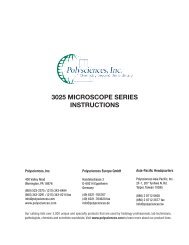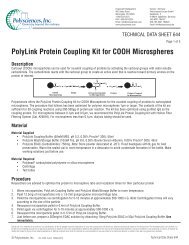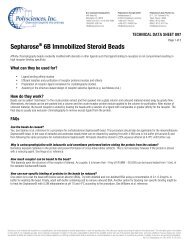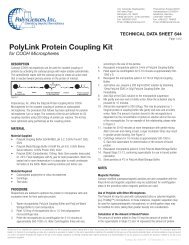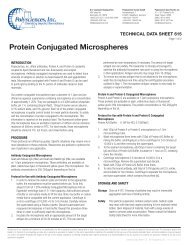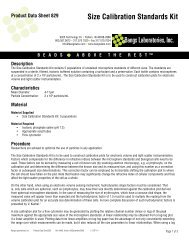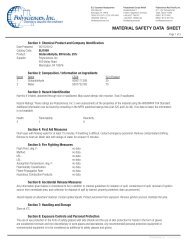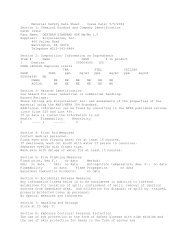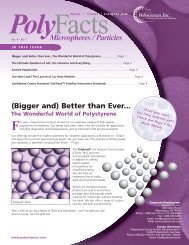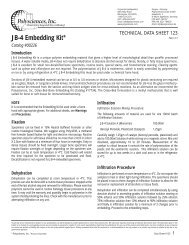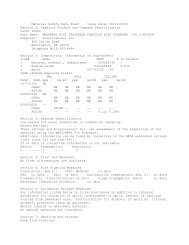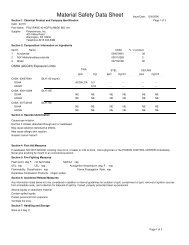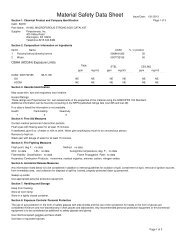Glutaraldehyde Coupling Kit with Hollow Fiber ... - Polysciences, Inc.
Glutaraldehyde Coupling Kit with Hollow Fiber ... - Polysciences, Inc.
Glutaraldehyde Coupling Kit with Hollow Fiber ... - Polysciences, Inc.
You also want an ePaper? Increase the reach of your titles
YUMPU automatically turns print PDFs into web optimized ePapers that Google loves.
U.S. Corporate Headquarters<br />
400 Valley Road<br />
Warrington, PA 18976<br />
1(800) 523-2575 / (215) 343-6484<br />
Fax: 1(800)343-3291<br />
Email: info@polysciences.com<br />
<strong>Polysciences</strong> Europe GmbH<br />
Handelsstrasse 3 D-69214<br />
Eppelheim, Germany<br />
+(49) 6221-765767<br />
Fax: +(49) 6221-764620<br />
Email: info@polysciences.de<br />
<strong>Glutaraldehyde</strong> <strong>Coupling</strong> <strong>Kit</strong><br />
<strong>with</strong> <strong>Hollow</strong> <strong>Fiber</strong> Filtering System<br />
TECHNICAL DATA SHEET 854<br />
Page 1 of 2<br />
O<br />
H<br />
C<br />
DESCRIPTION<br />
Amine-modified (NH 2<br />
) microparticles can be used for covalent coupling<br />
of proteins via a homobifunctional amine-reactive crosslinker such as<br />
glutaraldehyde (Figure 1).<br />
C<br />
<strong>Glutaraldehyde</strong><br />
O<br />
H<br />
H<br />
N<br />
Aldehyde Activated<br />
Microsphere<br />
O<br />
H<br />
C +<br />
H H<br />
<strong>Polysciences</strong>, <strong>Inc</strong>. offers the <strong>Glutaraldehyde</strong> <strong>Coupling</strong> <strong>Kit</strong> <strong>with</strong> <strong>Hollow</strong> <strong>Fiber</strong><br />
Filtering System for the covalent coupling of proteins to 100-500nm aminemodified<br />
microspheres.<br />
MATERIAL SUPPLIED<br />
• Bottle 1 (Component A): Phosphate buffered saline (PBS): 3 x 225ml<br />
• Bottle 2 (Component B): 8% <strong>Glutaraldehyde</strong> in PBS: empty labeled<br />
storage bottle<br />
• Bottle 3 (Component C): 0.2M Ethanolamine in PBS: 60ml<br />
• Bottle 4 (Component D): Bovine Serum Albumin (BSA): 60ml<br />
• Bottle 5 (Component E): Storage Buffer: 60ml<br />
• 25% <strong>Glutaraldehyde</strong>: 2 x 10ml ampoules<br />
• MicroKros hollow fiber filter device<br />
MATERIAL REQUIRED<br />
• Amine-modified polystyrene microspheres<br />
• Microcentrifuge tubes (2ml)<br />
• Rotator (end-over-end)<br />
N<br />
H<br />
H<br />
N<br />
+ C<br />
AML <strong>Glutaraldehyde</strong> Aldehyde Activated<br />
Microsphere<br />
Ligand <strong>with</strong><br />
available amine<br />
PROCEDURE<br />
Researchers are advised to optimize incubation times and protein to<br />
microsphere ratio for their particular protein. Directions for assembling and<br />
operating the MicroKros hollow fiber filter device may be found in Technical<br />
Data Sheet #606.<br />
Procedure for Preparing 18% <strong>Glutaraldehyde</strong> in PBS Solution<br />
1. Pipet 2ml of phosphate buffered saline (PBS) into Bottle 2.<br />
2. Using an ampoule cracker, open a 10ml ampoule of 25%<br />
<strong>Glutaraldehyde</strong>.<br />
H<br />
N<br />
Ligand bound via<br />
amide bond<br />
Figure 1: <strong>Glutaraldehyde</strong>-mediated coupling to amine-modified microspheres.<br />
O<br />
H<br />
C<br />
O<br />
H<br />
H<br />
N<br />
H<br />
N<br />
O<br />
H<br />
C +<br />
H<br />
H<br />
N<br />
Ligand <strong>with</strong><br />
available amine<br />
3. Pipet 5ml of 25% <strong>Glutaraldehyde</strong> into Bottle 2.<br />
4. Mix well. Store at 4˚C. Note: <strong>Glutaraldehyde</strong> can be unstable at a pH<br />
of 7.4 and may slowly start to polymerize. Please inspect the bottle<br />
of 18% <strong>Glutaraldehyde</strong> in PBS prior to each use. If turbid or cloudy,<br />
discard and prepare a fresh solution.<br />
H<br />
H<br />
Procedure for N<strong>Coupling</strong><br />
N<br />
1. Pipet 12.5mg of beads into a 2ml microcentrifuge tube (i.e. ~0.5ml<br />
of beads at 2.5% solids). Add 1ml of PBS (Component A) and mix by<br />
hand-shaking. Ligand bound via<br />
amide bond<br />
2. Transfer the diluted beads to one of the retentate syringes connected<br />
to the hollow fiber filter module and concentrate the beads to ~0.75ml<br />
(including the 0.5ml hold-up volume) by pushing the retentate syringes<br />
back and forth (Figure 2).<br />
3. Detach an empty retentate syringe and add 1ml of PBS to it. Re-attach<br />
this retentate syringe to the filtration module.<br />
4. Concentrate the beads again down to 0.75ml (including the 0.5ml<br />
hold-up volume).<br />
5. Repeat Steps #3 and 4.<br />
6. Detach the retentate syringe and add 0.75ml of PBS to it. Re-attach<br />
this retentate syringe to the filtration module and push the syringe<br />
down fully one time.<br />
7. Detach the retentate syringe containing the beads and transfer the<br />
washed spheres into a polypropylene tube. Add PBS until the total<br />
volume is ~1ml (if necessary). Add 0.75ml of 18% <strong>Glutaraldehyde</strong> in<br />
PBS (Component B).<br />
8. Mix for 4-6 hours at room temperature on a rotator, rocker table, rotary<br />
shaker or any other kind of device that provides end-to-end mixing.<br />
9. After incubating, transfer the beads to one of the retentate syringes<br />
connected to the hollow fiber filter module and concentrate the beads<br />
to ~0.75ml (including the hold-up volume).<br />
10. Detach an empty retentate syringe and add 1ml of PBS to it. Re-attach<br />
this retentate syringe to the filtration module.<br />
11. Concentrate the beads again down to 0.75ml (including the hold-up<br />
volume).<br />
12. Repeat Steps # 10 and 11, twice.<br />
13. Detach the retentate syringe and add 0.75ml of PBS to it. Re-attach<br />
this retentate syringe to the filtration module and push the syringe<br />
down fully one time.<br />
14. Detach the retentate syringe containing the beads and transfer the<br />
washed spheres into a polypropylene tube. Add PBS until the total<br />
volume is ~1.25ml. Mix by inversion or hand-shaking.<br />
15. Re-suspend protein in ~0.5ml of PBS and add to the glutaraldehydeactivated<br />
particles. Mix gently end-over-end or briefly vortex. The<br />
amount of protein to use during coupling may be determined using<br />
Table 1.<br />
16. <strong>Inc</strong>ubate protein / bead suspension overnight at room temperature <strong>with</strong><br />
gentle end-to-end mixing.<br />
17. Transfer the coated beads to one of the retentate syringes connected<br />
to the hollow fiber filter module and concentrate the beads to ~0.75ml<br />
(including the hold-up volume).<br />
Should any of our materials fail to perform to our specifications, we will be pleased to provide replacements or return the purchase price. We solicit your inquiries concerning all needs for life sciences work. The information given in this<br />
bulletin is to the best of our knowledge accurate, but no warranty is expressed or implied. It is the user’s responsibility to determine the suitability for their own use of the products described herein, and since conditions of use are beyond<br />
our control, we disclaim all liability <strong>with</strong> respect to the use of any material supplied by us. Nothing contained herein shall be construed as a recommendation to use any product or to practice any process in violation of any law or any<br />
government regulation.<br />
Technical Data Sheet 854 © <strong>Polysciences</strong>, <strong>Inc</strong>. - REV: OCT/28/2011
TECHNICAL DATA SHEET 854<br />
Page 2 of 2<br />
18. Detach the empty syringe and add 0.75ml of PBS to it. Re-attach this<br />
retentate syringe to the filtration module and push the syringe down<br />
fully one time.<br />
19. Detach the retentate syringe containing the beads and transfer the<br />
washed spheres into a polypropylene tube.<br />
20. Save the permeate in the filtrate syringe and transfer it into a small<br />
graduated cylinder or graduated centrifuge tube. Note the volume of<br />
the permeate and save it for protein determination. Note: If protein<br />
determination is done spectrophotometrically, make sure that the<br />
permeate is completely free of turbidity. The amount of protein added<br />
in Step 15 minus the amount in the permeate represents the amount<br />
bound to the microspheres.<br />
21. Add 1ml of 0.2M ethanolamine (Component C) to the washed beads.<br />
Mix gently for 30 minutes at room temperature. This step serves to<br />
block unreacted sites on the microspheres.<br />
22. Transfer the beads to one of the retentate syringes connected to the<br />
hollow fiber filter module and concentrate the beads to ~0.75ml<br />
(including the hold-up volume).<br />
23. Detach the empty syringe and add 0.75ml of BSA solution to it<br />
(Component D). Re-attach this retentate syringe to the filtration module<br />
and push the syringe down fully one time.<br />
24. Detach the retentate syringe containing the beads and transfer the<br />
washed spheres into a polypropylene tube. Add BSA until the total<br />
volume is ~1.25ml. Mix gently for 30 minutes at room temperature.<br />
The BSA will block any remaining polymer bead surfaces and minimize<br />
nonspecific protein binding in downstream assays.<br />
25. Transfer the blocked beads to one of the retentate syringes connected<br />
to the hollow fiber filter module and concentrate the beads to ~0.75ml<br />
(including hold-up volume).<br />
26. Detach the empty retentate syringe and add 1ml of Storage Buffer to it<br />
(Component E). Re-attach this retentate syringe to the filtration module.<br />
27. Concentrate the beads again down to ~0.75ml (including the hold-up<br />
volume).<br />
28. Detach the retentate syringe and add 0.75ml of Storage Buffer to it.<br />
Re-attach this retentate syringe to the filtration module and push the<br />
syringe down fully one time.<br />
29. Detach the retentate syringe containing the beads and transfer the<br />
spheres to a polypropylene tube. Add Storage Buffer until the total<br />
volume is ~1ml (if necessary). Mix by inversion or hand-shaking.<br />
Note: A single hollow fiber filter module may be used for all of the washes<br />
performed for a single coupling reaction. The device may be flushed out<br />
between washes to remove residual particles leftover in the hold-up volume.<br />
STORAGE AND SAFETY<br />
Storage<br />
Store the components of the kit, protein-coated microspheres, Bottle 2<br />
and the 25% <strong>Glutaraldehyde</strong> at 4˚C. Freezing of particles may result in<br />
irreversible aggregation and loss of binding activity.<br />
Safety<br />
<strong>Glutaraldehyde</strong> is harmful if absorbed through the skin. Avoid contact <strong>with</strong><br />
eyes, skin or clothing. Avoid breathing vapors. Use only <strong>with</strong> adequate<br />
ventilation. Wear protective gloves and safety goggles. In case of contact,<br />
immediately flush eyes or skin <strong>with</strong> plenty of water for at least 15 minutes.<br />
Remove contaminated clothing and shoes, and call a physician. Wash<br />
contaminated clothing and shoes before wearing again.<br />
This product is for research use only and is not intended for use in<br />
humans or for in vitro diagnostic use.<br />
ORDERING INFORMATION<br />
Cat. # Description Size<br />
23964 <strong>Glutaraldehyde</strong> <strong>Kit</strong> <strong>with</strong> <strong>Hollow</strong> <strong>Fiber</strong> Filtering System 1 kit<br />
Table 1<br />
Protein Amounts to Use <strong>with</strong> the <strong>Glutaraldehyde</strong> <strong>Kit</strong> <strong>Coupling</strong> Procedure<br />
Bead diameter<br />
(µm)<br />
Protein amount<br />
(mg)<br />
0.1 0.2 0.3 0.4 0.5<br />
2.0 – 5.0 1.0 – 2.5 0.75 – 1.75 0.5 – 1.25 0.4 – 1.0<br />
TO ORDER<br />
Male Luer<br />
Connection<br />
Syringe<br />
collects<br />
filtrate<br />
Luer Cap<br />
Male Luer<br />
Connection<br />
In The U.S. Call: 1(800) 523-2575 • (215) 343-6484<br />
In The U.S. Fax: 1(800) 343-3291 • (215) 343-0214<br />
Retentate<br />
(Sample) Syringe<br />
Luer Tee<br />
Luer Cap<br />
<strong>Hollow</strong> <strong>Fiber</strong> Filter<br />
Flow<br />
One Way<br />
Check Valve<br />
Luer Tee<br />
Retentate<br />
(Sample) Syringe<br />
In Germany Call: +(49) 6221-765767<br />
In Germany Fax: +(49) 6221-764620<br />
Figure 2: Schematic of MicroKros <strong>Hollow</strong> <strong>Fiber</strong> Filter<br />
Order online anytime at www.polysciences.com<br />
Should any of our materials fail to perform to our specifications, we will be pleased to provide replacements or return the purchase price. We solicit your inquiries concerning all needs for life sciences work. The information given in this bulletin<br />
is to the best of our knowledge accurate, but no warranty is expressed or implied. It is the user’s responsibility to determine the suitability for their own use of the products described herein, and since conditions of use are beyond our control,<br />
we disclaim all liability <strong>with</strong> respect to the use of any material supplied by us. Nothing contained herein shall be construed as a recommendation to use any product or to practice any process in violation of any law or any government regulation.<br />
Technical Data Sheet 854 © <strong>Polysciences</strong>, <strong>Inc</strong>. - REV: OCT/28/2011



